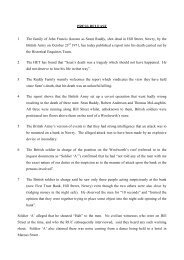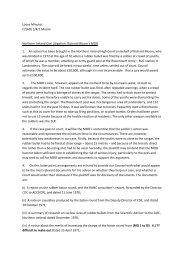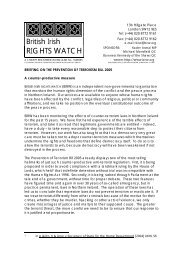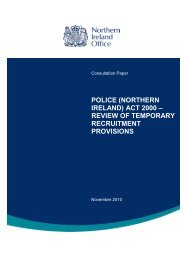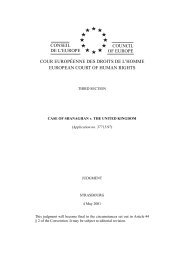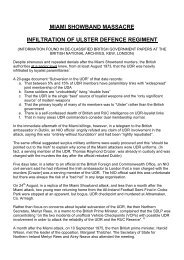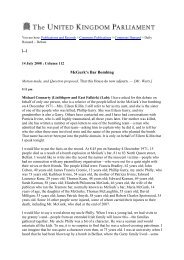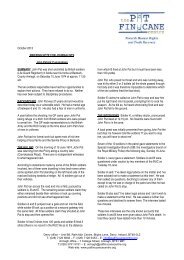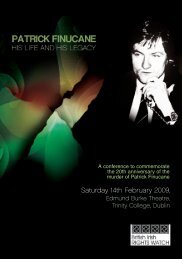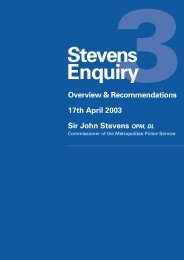Supplemental Skeleton Argument - The Pat Finucane Centre
Supplemental Skeleton Argument - The Pat Finucane Centre
Supplemental Skeleton Argument - The Pat Finucane Centre
You also want an ePaper? Increase the reach of your titles
YUMPU automatically turns print PDFs into web optimized ePapers that Google loves.
IN THE HIGH COURT OF JUSTICE IN NORTHERN IRELAND<br />
QUEEN’S BENCH DIVISION<br />
IN THE MATTER OF AN APPLICATION BY MARIE LOUISE THOMPSON<br />
FOR JUDICIAL REVIEW OF A DECISION OF THE DIRECTOR OF<br />
PUBLIC PROSECUTIONS<br />
SUPPLEMENTARY SKELETON ARGUMENT<br />
THE PROSECUTION TEST<br />
1. A reasonable prospect of conviction exists if, in relation to an identifiable<br />
individual, there is credible evidence which the prosecution can adduce before a<br />
court upon which evidence an impartial jury (or other tribunal), properly directed<br />
in accordance with the law, may reasonably be expected to find proved beyond<br />
reasonable doubt the commission of a criminal offence by the individual who is<br />
prosecuted (See Re Adams’s Application [2001] NI 1 p.9 Letter g).<br />
2. A realistic prospect of conviction is an object of test. It means that a judge or<br />
jury, properly directed in accordance with the law, is more likely than not to<br />
convict the defendant of the charge alleged. This is a separate test from the one<br />
the criminal courts themselves must apply.<br />
3. By letter dated 23 October 2002 (pp.102-103 of the Bundle) the DPP said that it<br />
was apparent that the decision not to prosecute was based on a “professional and<br />
considered judgment”. <strong>The</strong> author of the letter was not the decision-maker and<br />
the decision was made some considerable time ago. We had understood that we,<br />
and the Court, had been provided with copies of all the papers that are on the<br />
prosecution file. It, however, appears from this letter and from the letter dated 27<br />
February (pp.117-119 of the Bundle) that this may not be so. If there are other<br />
documents on the prosecution file relating to its decision not to prosecute the<br />
Court should be so informed and the material provided to the Court.<br />
4. If, on the other hand, there are no other documents the contention that the<br />
decision was based on a “professional and considered judgment” is an<br />
unwarranted assumption by the letter writer.<br />
1
5. We do not even know the identity or rank of the decision-maker and there is no<br />
suggestion that independent Counsel were involved in any shape or form in the<br />
decision not to direct a prosecution.<br />
6. Apart from an assumption on the part of the letter writer we are unclear as to the<br />
basis upon which it is asserted that the decision was based on a “professional and<br />
considered judgment”.<br />
REASONS FOR THE DECISION NOT TO PROSECUTE<br />
7. In any event the two reasons advanced for the decision were:<br />
(i) <strong>The</strong> evidence available was insufficient to afford a reasonable prospect of<br />
obtaining a conviction of any identifiable individual in respect of any<br />
offence arising out of the death of the deceased;<br />
(ii) That there was not a reasonable prospect of rebutting the defence of selfdefence.<br />
[See also letter dated 27 February 2003 (pp.117-119 of the Bundle)]<br />
REASON (i)<br />
8. <strong>The</strong> reasons advanced for the impugned decision are legally perverse. As to<br />
reason (i) Kerr J refers in his judgment, at para.2, to “the soldier who effectively<br />
discharged the shot that caused the death of Mrs Thompson …”. In context this<br />
clearly can only have referred to Soldier D and the Chief Justice clearly<br />
proceeded on the basis that there was no lack of sufficient evidence to identify the<br />
soldier who shot the deceased.<br />
9. This is hardly surprising since it is apparent from the papers which we hold in the<br />
case that there is sufficient evidence to demonstrate that the deceased was shot by<br />
Soldier D namely:<br />
(i)<br />
(ii)<br />
Soldier D made a statement to the RMP to the effect that he shot an SLR<br />
twice into the rear garden of 129 Rathlin Drive;<br />
<strong>The</strong> deceased was shot while in the rear of 129 Rathlin Drive.<br />
2
(iii)<br />
(iv)<br />
(v)<br />
(vi)<br />
<strong>The</strong> autopsy report confirms that the deceased was killed by a high<br />
velocity bullet;<br />
<strong>The</strong> bullets discharged by Soldier D were high velocity bullets;<br />
Soldier D was one of four soldiers who were operating as a unit and no<br />
other members of his unit claim to have fired shots;<br />
Soldier D never suggested that someone other than him was responsible<br />
for the shooting of the deceased.<br />
10. <strong>The</strong> circumstantial evidence surrounding the shooting of the deceased<br />
overwhelmingly points to Soldier D as being responsible. It is absurd, in the light<br />
of the totality of the evidence, for anyone to conclude that there was<br />
“insufficient” evidence to afford a reasonable prospect of identifying Soldier D as<br />
the shooter.<br />
11. Even the self-serving statements made by the soldiers in the most favourable<br />
environment possible cannot disguise the fact that Soldier D was responsible for<br />
the shooting of the deceased. <strong>The</strong> suggestion by the DPP in 1972 that there was<br />
insufficient evidence of this fact is unsustainable and offensive to the intelligence<br />
of the family of the deceased.<br />
12. <strong>The</strong> decision not to prosecute on this ground was wrong in 1972 and it remains<br />
so. <strong>The</strong> passage of time cannot rescue the decision and it remains as offensive to<br />
the family now as it did in 1972. <strong>The</strong> fact that the Respondent seeks to uphold the<br />
decision not to prosecute on precisely the same impugned grounds is a matter of<br />
deep concern.<br />
REASON (ii)<br />
13. In its letter dated 27 February 2003 {pp.117-118 of the Bundle) the Respondent<br />
elaborates by referring to the statements of the military personnel. Specifically<br />
the letter states:<br />
“I refer you to the statements of the military personnel … in which<br />
reference is made, inter alia, to ‘a male person holding what appeared to<br />
be a .22 rifle’; ‘… I heard one single shot probably fired from a .22 rifle.<br />
<strong>The</strong> shot appeared to come from the rear of 129 Rathlin Drive””.<br />
3
14. This is merely a recitation of the self-serving highlights of some of the soldiers’<br />
statements to the RMP. It completely overlooks the fact that the statements of the<br />
four soldiers who were operating as a unit and who were in close proximity to<br />
each other at the time of the shooting are contradictory in significant respects:<br />
(i) Only one soldier aside from Soldier D claims to have seen a gunman;<br />
(ii) None of the soldiers other than Soldier D claims to have heard shots.<br />
Despite this neither soldier D nor the other soldiers were ever re-interviewed in<br />
order to explore the discrepancies within their statements.<br />
15. <strong>The</strong>se discrepancies emerged notwithstanding that the statements were taken in<br />
the most favourable conditions. As Kerr J pointed out:<br />
“Quite apart from that however, the fact that each of the interviews<br />
cannot have lasted any more than half an hour; the fact that clear<br />
discrepancies appear in the statements made, discrepancies which have<br />
not been the subject of further challenge or investigation, are sufficient<br />
to demonstrate the inadequacy of the investigation into the death of the<br />
deceased.”<br />
16. Quite apart from the discrepancies and the self-serving portions of the soldiers’<br />
statements relied upon by the Respondent there is a large body of other credible<br />
civilian evidence which contradicts the untested accounts.<br />
17. <strong>The</strong> wholly uncritical acceptance and reliance upon the untested and self-serving<br />
portions of the soldiers’ statements is inconsistent with the conscientious<br />
discharge of the important prosecutorial function. This is particularly so in cases<br />
involving the use of lethal force by servants and agents of the State.<br />
18. At the very least, if the Respondent was to be in a position to reach the<br />
conclusion it did on this issue it would have to demonstrate that it had properly<br />
analysed the totality of the soldiers’ evidence in the context of all the other<br />
relevant evidence.<br />
19. Prosecutors must protect the public interest, act with objectivity, take proper<br />
account of the position of the suspect and the victim and pay attention to all<br />
relevant circumstances irrespective of whether they are to the advantage or<br />
disadvantage of the suspect.<br />
20. It was perverse for the Respondent to simply refer to those portions of the<br />
soldiers’ statements and to conclude from that alone that there was not a<br />
reasonable prospect of rebutting the defence of self-defence.<br />
4
21. If the approach of the Respondent, demonstrated in this case, had been followed<br />
in cases such as Thain, Clegg, Fisher & Wright, the soldiers in these cases would<br />
never have been prosecuted.<br />
CONCLUSION<br />
22. For the above reasons it is submitted that the decision not to prosecute Soldier D<br />
cannot be sustained.<br />
Dated: 16 September 2004<br />
SEAMUS TREACY QC SC<br />
KAREN QUINLIVAN BL<br />
5



